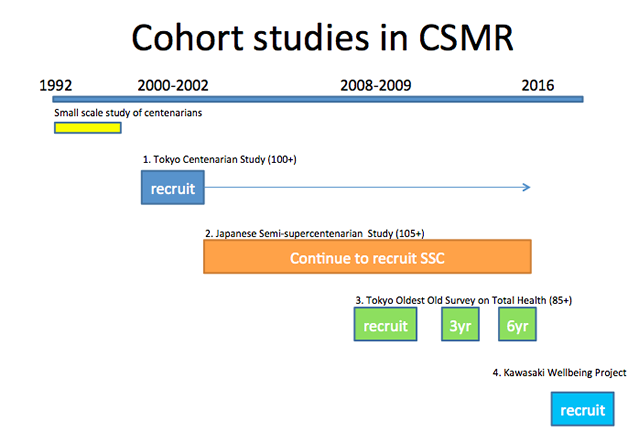Project overview
Since Professor Nobuyoshi Hirose, serving as Special Invitation Professor, started a centenarian study in Tokyo in 1992, at the Keio University School of Medicine we have continued research on centenarians and semi-supercentenarians (individuals >105 years old).
At the time Prof Hirose initiated this research, nationwide there were 4,152 centenarians in Japan (corresponding to 1/50th of the current number), and they were considered quite rare. That year, a commercial called ‘Kin’s 100-year-old, Gin’s 100 years, too!’ became a big hit, and centenarians began to attract attention. Mainly due to the work of Professor Hirose, doctors from the Arteriosclerosis Research Group of Division of Geriatric Medicine visited centenarians at their homes, conducting a survey of 20–30 individuals a year.
Between 2000 and 2002, we conducted a baseline survey for the Tokyo Centenarian Study (TCS), in collaboration with the Tokyo Metropolitan Institute of Gerontology. This research was carried out as an interdisciplinary gerontological study, in which researchers in the fields of medicine, psychosocial sociology, nursing science, and nutrition science cooperated. Over the two years, 514 centenarians participated in the questionnaire survey, and 304 in the medical investigations. A tracking survey, conducted by phone and mail, is still ongoing.
Through this research, it became clear that those centenarians with higher activities of daily living (ADL) and cognitive functions had a greater likelihood of living to 105 years old. Furthermore, those who become supercentenarians, over 110 years old, were found to have presented with extremely high ADL and cognitive function at the age of 100. Therefore, in 2002, we began a nationwide Japanese Semi-supercentenarian Study (JSS) to research people over 105 years old. Among those who are over 100 years old, very few survived to 105 years or beyond. Professor Hirose started a nationwide survey in 2002 as we could not identify a sufficient number of semi-supercentenarians in the Tokyo Metropolitan Area, and we continue to recruit.
Even if researching centenarians, semi-supercentenarians, and supercentenarians did reveal factors contributing to healthy longevity, it would be necessary to reexamine whether the same factors lead to longer healthy life in the general elderly population. Therefore, since 2008, we have been conducting a survey of the very elderly living in the central area of Tokyo (the Tokyo Oldest Old Survey on Total Health [TOOTH]). In the TOOTH survey, in addition to reproducing the results of our previous research on centenarians, we are also considering exercise habits, physical functions, and dietary habits, which are difficult to implement in the study of centenarians.
Our research is based on the willing participation of centenarians and semi-supercentenarians, their family members, and the staffs of nursing-care facilities. All of us thank them from the bottom of our hearts.
We have various investigations and collaborative research projects planned even after 2016 at the Center for Supercentenarian Medical Research. The progress of future projects will be made available on this website from time to time.
September 2016
Center for Supercentenarian Medical Research
Dr. Yasumichi Arai, MD, PhD


